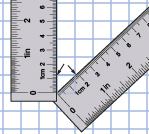Section 1
1. Section 1
1.8. Explore 3
Section 1: Viewing and Representing 3-D Objects

You may have noticed while drawing on the graph paper that the diagonal line sections are longer than the horizontal and vertical sections. The diagram shown here illustrates this difference.
A third way to represent a 3-D object in a two-dimensional diagram is to use isometric dot paper. This paper is great for drawing shapes to scale because every diagonal and vertical dot is an equal distance apart. Print several copies of isometric dot paper for this lesson.
Representations using isometric dot paper are called edge or corner views.
Example
Draw on isometric dot paper an edge or corner view of a rectangular prism that is 3 units wide, 2 units high, and 5 units long.
Solution
Watch Drawing a Rectangular Prism.
Read pages 234 to 237 for an additional example on using isometric dot paper. As you read through the example, don’t worry about how the scale of the box is found. You will spend time with scale drawings later in this module. For now, pay careful attention to steps 1 to 6 that focus on drawing with isometric paper.
The following interactive geoboard allows you to form isometric diagrams of three-dimensional figures.
Try This 3
Use the interactive geoboard or isometric dot paper to draw an isometric sketch of the three-dimensional object shown in 3D Object Applet.
![]() Save a screenshot of your isometric sketch to your course folder.
Save a screenshot of your isometric sketch to your course folder.


